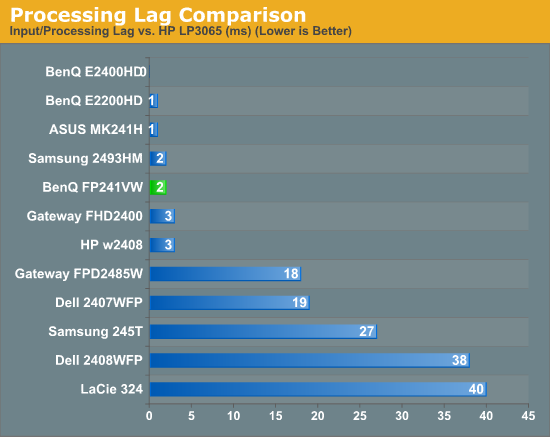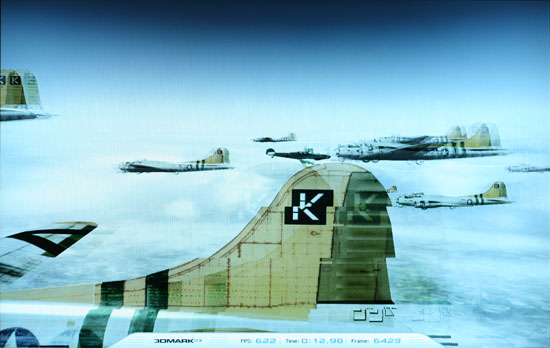Display Lag and Response Time
One of the areas where the A-MVA panel does extremely well is in the areas of display lag and pixel response time. Just to recap, you may have heard complaints about "input lag" on various LCDs, so that's one area we look at in our LCD reviews. We put input lag in quotation marks because while many people call it "input lag", the reality is that this lag occurs somewhere within the LCD panel circuitry, or perhaps even at the level of the liquid crystals. Where this lag occurs isn't the concern; instead, we just want to measure the duration of the lag. That's why we prefer to call it "processing lag" or "display lag".
To test for display lag, we run the Wings of Fury benchmark in 3DMark03, with the output set to the native LCD resolution - in this case 1920x1200. Our test system is a quad-core Q6600 running a Radeon HD 3870 on a Gigabyte GA-X38-DQ6 motherboard - we had to disable CrossFire support in order to output the content to both displays. We connect the test LCD and a reference LCD to two outputs from the Radeon 3870 and set the monitors to run in clone mode.
The reference Monitor is an HP LP3065, which we have found to be one of the best LCDs we currently possess in terms of not having display lag. (The lack of a built-in scaler probably has something to do with this.) While we know some of you would like us to compare performance to a CRT, that's not something we have around our offices anymore. Instead, we are looking at relative performance, and it's possible that the HP LP3065 has 20ms of lag compared to a good CRT - or maybe not. Either way, the relative lag is constant, so even if a CRT is faster at updating, we can at least see if an LCD is equal to or better than our reference display.
While the benchmark is looping, we snap a bunch of pictures of the two LCDs sitting side-by-side (using a relatively fast shutter speed). 3DMark03 shows the runtime with a resolution of 10ms at the bottom of the display, and we can use this to estimate whether a particular LCD has more or less processing lag than our reference LCD. We sort through the images and discard any where the times shown on the LCDs are not clearly legible, until we are left with 10 images for each test LCD. We record the difference in time relative to the HP LP3065 and average the 10 results to come up with an estimated processing lag value, with lower numbers being better. Negative numbers indicate a display is faster than the HP LP3065, while positive numbers mean the HP is faster and has less lag.
It's important to note that this is merely an estimate - whatever the reference monitor happens to be, there are some inherent limitations. For one, LCDs only refresh their display 60 times per second, so we cannot specifically measure anything less than approximately 17ms with 100% accuracy. Second, the two LCDs can have mismatched vertical synchronizations, so it's entirely possible to end up with a one frame difference on the time readout because of this. That's why we average the results of 10 images, and we are confident that our test procedure can at least show when there is a consistent lag/internal processing delay. Here is a summary of our results for the displays we have tested so far.
 |
| Display Input/Processing Lag vs. HP LP3065 | |||||||||||
| One | Two | Three | Four | Five | Six | Seven | Eight | Nine | Ten | Avg. (ms) | |
| ASUS MK241H | 10 | 0 | 0 | 0 | 0 | 0 | 0 | 0 | 0 | 0 | 1 |
| BenQ E2200HD | 0 | 0 | 0 | 10 | 0 | 0 | 0 | 0 | 0 | 0 | 1 |
| BenQ E2400HD | 0 | 0 | 0 | 10 | -10 | 0 | -10 | 0 | 0 | 10 | 0 |
| BenQ FP241VW | 0 | -10 | 0 | 10 | 0 | 10 | 0 | 0 | 10 | 0 | 2 |
| Dell 2407WFP | 10 | 20 | 30 | 20 | 10 | 10 | 30 | 30 | 10 | 20 | 19 |
| Dell 2408WFP | 30 | 40 | 40 | 40 | 30 | 30 | 40 | 30 | 50 | 50 | 38 |
| Gateway FHD2400 | -10 | -10 | 0 | 10 | 10 | 10 | 0 | 10 | 10 | 0 | 3 |
| Gateway FPD2485W | 30 | 10 | 20 | 20 | 20 | 10 | 0 | 30 | 20 | 20 | 18 |
| HP w2408 | 10 | 10 | 0 | 0 | 0 | 0 | 0 | 10 | 0 | 0 | 3 |
| LaCie 324 | 40 | 30 | 40 | 30 | 40 | 50 | 40 | 50 | 50 | 30 | 40 |
| Samsung 245T | 30 | 30 | 30 | 30 | 30 | 20 | 30 | 30 | 20 | 20 | 27 |
| Samsung 2493HM | 0 | 10 | 0 | 0 | 0 | 10 | 0 | -10 | 0 | 10 | 2 |

As you can see, all of the S-PVA panels we have tested to date show a significant amount of input lag, ranging from 20ms up to 40ms. In contrast, the TN and S-IPS panels show little to no processing lag (relative to the HP LP3065). The BenQ FP241VW performs similarly to the TN and IPS panels, with an average display lag of 2ms - not something you would actually notice compared to other LCDs. Obviously, if you're concerned with display lag at all, you'll want to avoid S-PVA panels for the time being. That's unfortunate, considering S-PVA panels perform very well in other areas.
 |
Despite what the manufacturers might advertise as their average pixel response time, we found most of the LCDs are basically equal in this area - they all show roughly a one frame "lag", which equates to a response time of around 16ms. In our experience, processing lag is far more of a concern than pixel response times. Taking a closer look at just the FP241VW, we can see the typical one frame lag in terms of pixel response time. However, the panel does appear to be a little faster in response time than some of the other panels we've tested (notice how the "ghost image" isn't as visible as on the HP LP3065), and we didn't see parts of three frames in any of the test images.
Update: What Causes Display Lag?
After the initial article went live, one of our readers who works in the display industry sent me an email. He provides some interesting information about the causes of image lag. Below is an (edited) excerpt from his email. (He wished to remain anonymous.)
PVA and MVA have inherent drawbacks with respect to LCD response time, especially gray-to-gray. To address this shortcoming, companies have invested in ASICs that perform a trick generically referred to as "overshoot." The liquid crystal (LC) material in *VA responds sluggishly to small voltage changes (a change from one gray level to another). To fix this, the ASIC does some image processing and basically applies an overvoltage to the electrodes of the affected pixel to spur the LC material into rapid movement. Eventually the correct settling voltage is applied to hold the pixel at the required level matching the input drive level.
It's very complicated math taking place in the ASIC in real time. It works well but with an important caveat: it requires a frame buffer. What this means is that as video comes into the panel, there is a memory device that can capture one whole video frame and hold it. After comparing it to the next incoming frame, the required overshoot calculations are made. Only then is the first captured frame released to the panel's timing controller, which is when the frame is rendered to the screen. As you may have already guessed, that causes at least one frame time worth of lag (17ms).
Some companies discovered some unintended artifacts in their overshoot calculations and the only way they saw to correct these was to allow for their algorithm to look ahead by two frames instead of one. So they had to up the memory of the frame buffer and now they started capturing and holding not one but two frames upon which they make their complex overshoot predictions to apply the corrected pixel drive levels and reduce gray-to-gray response time (at the expense of lag time). Again, it works very well for improving response time, but at the expense of causing lag, which gamers hate. That in a nutshell is the basis of around 33ms of the lag measured with S-PVA.
[End Excerpt - the following is not from our reader]
Not every display uses this approach, but this could account for the increase in display lag between earlier S-PVA and later S-PVA panels. It's also important to note that I tested the Dell 2408WFP revision A00, and apparently revision A01 does not have as much lag. I have not been able to confirm this personally, however. The above also suggest that displays designed to provide a higher image quality through various signal processing techniques could end up with more display lag caused by the microchip and microcode, which makes sense. Now all we need are better algorithms and technologies in order to reduce the need for all of this extra image processing -- or as we have seen with some displays (particularly HDTVs), the ability to disable the image processing.










114 Comments
View All Comments
genegold - Saturday, August 15, 2009 - link
Jared - Take a look at HP's Business/Performance monitors for four new IPS models and two PVAs.While I've never seen a PVA monitor, one thing I've read in serious user discussions is how they are made for photo professionals and not for use with typical web/office/standard applications. For the latter, these monitors' colors are oversaturated and the text mediocre or worse. Users who have bought them for the latter frequently complain and are advised to return them for something more for the consumer market. The common theme is that these monitors are made for use with Adobe Photoshop and to some degree with other color-managed applications (of which Firefox is the only browser).
I did try a Dell 2209WA E-IPS recently, actually two samples, and found them to be very good monitors for everyday use, with the big exception for my purposes that the model's minimum brightness setting (0%) is equivalent to a bright office. That didn't work well with my moderate day lighting and evening darkness (and aging hazel eyes).
gking11 - Thursday, August 6, 2009 - link
I got my FP241VW a couple of months ago after I was lucky enough to find it for sale online, and brand new to boot!While I did get a dead pixel (fortunately it was low enough that it didn't hinder my viewing much), the display is the closest thing to perfection in terms of an all-purpose LCD, especially for gaming. With my Pantone Huey, I have it calibrated and, boy, do the colors come out!
Without further ado, here's the direct link to the site where I bought it from (it's $385 as of this post, I bought it for $400 then): http://www.entercomputers.com/benq-fp241vw-24-wide...">http://www.entercomputers.com/benq-fp24...l?SID=cf...
*Running away from stampede!*
rlx - Sunday, July 19, 2009 - link
Two points often disregarded in reviews.I bought a Samsung SM275T and although I am very happy with it, I find the readability of small anti-aliased text to be not as good as I expected. I find the reason to be that each pixel is in fact made of two pixels on that monitor. Both subpixels combine to double the number of different colors the monitor can display. I find that in some cases one subpixel is on while the one below is off.
This creates a dithering effect and somehow interacts with antia-liased text. The net effect is that I find small text to be harder to read )or I should say recognize). I compared with an analog monitor and with a 720P LCD tv and I am quite sure that using two subpixels the way Samsung does it is not the way to go for a monitor that is intended for general use.
The other point is that vertical viewing angles are very important to me on a portable computer screen. Since my vision is not that good I sometimes need to move my head closer to the screen and this movement changes the angle of view. This is why I find laptops (TN) very difficult to use. People with normal vision can do everything from a single position and the vertical angle of view might not be as important for them.
Richard
rlx - Wednesday, July 22, 2009 - link
I meant twice the number of gray levels of course (re. twice the number of colors) but why Samsung has done all that work of doubling the number of pixels just to gain one bit in the number of gray levels.If both sub-pixels have a slightly different number of levels, say sub-pixel No.1 has four levels of gray 0,1,2,3 and sub-pixel No.2 has 6 0,1,...,5 then the number of achiveable gray levels is 24 out of 31. They are 0, 3/15, 5/15, 6/15, ... up to 2.
The light coming through sub-pixel No.1 is l1/3 and the light through No.2 is l2/5. The total light through both is (l1*5 + l2*3)/15.
The 24 achivable levels out of the possible 31 are, (going from 0 to 30): 1001011011111111111111101101001.
If one scales those numbers up then one sees why Samsung can do much better than double the number of gray levels by using two sub-pixels instead of a single pixel.
Maybe I learned something from my typo.
rlx - Tuesday, July 21, 2009 - link
I just wish to clarify my statement about the readability of small size anti-aliased text on the SM275T. I double checked with my older analog SM950P that I run at 1600x1200. From a distance, the small text is definitely much easier to read on the SM275T.I am a bit annoyed by the dithering effect when I take my glasses off so I can get close to the screen. From that short range, small size text looks smooth on the analog screen while artifacts appear on the SM275T.
However even at this small range the text on the SM275T is still readable while it is not really so on the analog screen.
- Sunday, July 19, 2009 - link
Just wanted to say great review, it mirrored my sentiments exactly.P-MVAs (A-MVAs perhaps not as much) were incredible displays. Found in $300 24" soyos I was amazed how much better they were than pre-highgamut S-PVAs in every regard(color response and even slightly in gamma shift). When AUO stopped their entire MVA line it was party over for cheap high quality displays, as Samsung thinks alittle too highly of it PVA technology.
Although I still have an LG 24" with a P-MVA, my other two recent additions were H-IPS HP2475w. Great deals at $600 and worth every penny and then some, but still not bending the price curve down enough. TN has its place, but not in anything over $150 imho.
Sabresiberian - Thursday, July 9, 2009 - link
Beats the heck out of any LCD made to date. Yeah they were $2500 when they were made, but that would likely be much less now, especially if it were made for gamers not professionals and priced to sell properly to that market.Sorry, I just had to say it; maybe there's a Sony exec that reads Anandtech and will get sparked, lol!
Mr Bill - Friday, June 26, 2009 - link
I bought this monitor last fall from BenQ for $400 just before they went out of production. I wish I had bought two. Its a very nice monitor.ocyl - Thursday, June 25, 2009 - link
Thanks, Jarred, for the efforts that you've put into writing this article. Here is a bit of idea sharing :)1. You might be interested to check out NEC's MultiSync P221W (S-PVA, 1000:1 contrast, black level control, GammaComp, sRGB preset, 4-way adjustable stand, 16ms response time; $500) and the newly announced E222W (looks like a PVA given its 178º viewing angle; 1000:1 contrast, sRGB preset, 4-way adjustable stand, 5ms response time; $270). I spent two weeks of time on research when I was in the market for a new TFT-LCD monitor last November. I ended up purchasing a NEC MultiSync LCD1990SX (LTM190E4 PVA, 1500:1 contrast, ColorComp, OmniColor, black level control, sRGB preset, 4-way adjustable stand, 20ms response time; $480) and couldn't have been happier.
2. As we know, scaling is one of the main contributors to processing delay. While I don't currently own a Radeon and therefore don't know if this can be done in Catalyst, it's possible to relieve monitor from scaling tasks in ForceWare. There are four options available at nVidia Control Panel -> Display -> Change Display (Flat Panel) Scaling: Use nVidia Scaling, Use nVidia Scaling with Fixed Aspect Ratio, Use My Display's Built-in Scaling, and Do Not Scale. I don't have measuring equipment so I can't perform any meaningful investigation, but perhaps it's something that AnandTech may find worthwhile looking into.
ocyl - Friday, July 17, 2009 - link
NEC announces MultiSync EA231WMi, a 23" IPS monitorhttp://www.techpowerup.com/99491/NEC_Unveils_Multi...">http://www.techpowerup.com/99491/NEC_Un...t_23_inc...